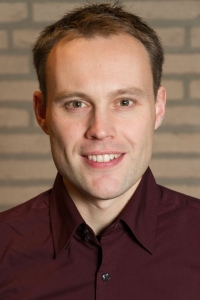
Clinical fellowship for Peter van den Akker

Peter van den Akker, MD, PhD, clinical geneticist, has been awarded a ZonMw clinical fellowship for his proposal Genetic therapy through exon-skipping for dystrophic epidermolysis bullosa . He is one of five recipients for this award selected from 53 initial applicants. A ZonMw Clinical Fellowship (€160,000) is a personal grant to young medical specialists/clinician scientists to help them to establish their own research programme and to enable them to combine their clinical work with 2 days of research per week for a period of 5 years.
Summary of research proposal
Patients with the devastating skin disorder ‘generalized severe’ recessive dystrophic epidermolysis bullosa (RDEB) get blisters all over their body from any friction, are in constant pain, and die of skin cancer before the age of 40. Their skin completely lacks type VII collagen (COLVII), an essential epidermal-dermal adhesion protein, due to mutations in the COL7A1 gene. There is no cure for RDEB and thus a great need for new therapeutic strategies.
Based on the ideal characteristics of COL7A1, we developed a personalized genetic therapy approach for RDEB using ‘Antisense OligoNucleotide (AON)-mediated exon-skipping’. AONs are short, modified RNA-molecules designed to modulate the splicing of in-frame exons containing mutations, leading to the deletion (‘skipping’) of the exon with the mutation from the mRNA without disrupting the reading frame. Instead of no protein at all (the amino acids encoded by the ‘skipped’ exon are absent), the AON-approach in RDEB is predicted to create a slightly shorter, yet partly functional, COLVII. Although this ‘skipped protein’ may not lead to a complete cure, it should appreciably ameliorate the phenotype. This would not only markedly improve patients’ quality of life, but also have a major socio-economic impact on the costs of their healthcare.
We performed successful proof-of-concept experiments for the exon-skipping approach in vitro in cell-based systems and pilot experiments in our skin-humanized mouse model. The results demonstrate the huge and realistic therapeutic potential of the exon-skipping approach for RDEB.
Our ultimate goal is to bring the exon-skipping approach to clinical applicability for RDEB. This project aims therefore, as a first step towards clinical applicability, to address those fundamental aspects that are essential for achieving Clinical Trial Readiness (CTR): developing exon-skipping into a generic approach for COL7A1 in order to target larger patient groups; demonstrating the systemic treatment potential of the exon-skipping approach and restoration of skin architecture and phenotype improvement in our mouse model; developing a reliable molecular read-out for the exon-skipping approach; and determining the amount of ‘skipped COLVII’ that exon-skipping should ideally yield.
Further aspects to reach Clinical Trial Readiness (CTR) will be covered by other projects, in which the Groningen Centre for Blistering Diseases is participating, and in collaboration with peer groups. At the end of this project, we expect to be close to CTR for applying the ‘Antisense OligoNucleotide (AON)-mediated exon-skipping’ approach on RDEB patients.
This project will bridge the gap between lab and clinic for the exon-skipping approach. As a specialist working at the crossroads of genetics and dermatology, with access to patients, patient organizations, and research infrastructure, and with expertise in basic and translational science, Peter van den Akker is in an excellent position to perform this work. The Clinical Fellowship will allow him to establish his own research programme on personalized genome-based therapies for genetic skin diseases.
The project team consists of Marjon Pasmooij, postdoc in Dermatology; Jeroen Bremer, PhD student; Richard Sinke, Professor of Genome Diagnostics; Marcel Jonkman, Professor of Dermatology, (all UMCG); Annemieke Aartsma-Rus, associate professor in Human Genetics, LUMC, Leiden; and Irwin McLean, Professor of Human Genetics, University of Dundee, Scotland. The work is further supported by the Dutch Butterfly Child Foundation (Stichting Vlinderkind), the Dutch Rare Diseases Fund (Zeldzame Ziektenfonds), and an E-RARE Young Investigator grant (2012).
Summary of Peter's work in past five years
In 2009, he started his PhD project funded by a ZonMW AGIKO stipend. This led to his graduation Cum Laude in 2013, 10 published papers (6 as first author), several grants and awards, a short research project in London, and several invitations for international work visits and lectures. In the meantime, he finished his clinical genetics specialisation in 2012, and is now working as a clinical geneticist with a special interest in genetic skin disorders in the Department of Genetics.
During his PhD project, he initiated the AON-mediated exon-skipping project for DEB and the successful in vitro proof-of-concept studies. This led to the formation of the ‘Exon-skipping therapy for EB’ research group, a collaboration between the Departments of Genetics and Dermatology, UMCG. In 2012, he was a co-investigator on the E-RARE Young Investigator application entitled ‘Splicing Therapies for EB’ and awarded to his collaborator Marjon Pasmooij.
His work on The International DEB Patient Registry (www.deb-central.org) has established his name in the field, allowing him to build up a strong international network of colleagues and patient organizations. For this registry, he collaborated with five international EB centres, EB-Clinet (international network of expert EB-centres), and DEBRA International (patient organization). He became chair of the EB-Clinet workgroup for developing a clinical trial register, which will provide researchers with access to patient groups for clinical research.
One of the most important outcomes of his translational PhD studies was the mathematical demonstration that ‘natural gene therapy’ (revertant mosaicism) should be expected to occur in all DEB patients. This is highly relevant, since revertant cells could provide the ultimate source of patient-own cells required for a permanent cure.
In addition, as a post-doctoral researcher, he participates in the successful EB research programme of the Groningen Centre for Blistering Diseases, UMCG. Projects include solving patient ‘cold-cases’ by new diagnostic methods, and investigating different aspects of natural gene therapy.
More news
-
15 September 2025
Successful visit to the UG by Rector of Institut Teknologi Bandung
